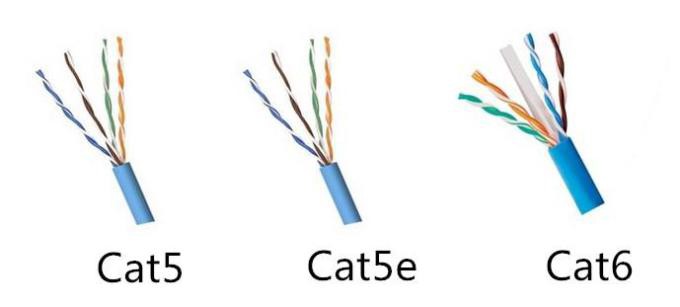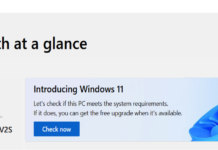Today, there are many products that come with new features considering the latest requirement. And these days, Cat5 and Cat6 connectors also consider the most important part when it comes to networking. But some of them are not aware of its features and get confused by Cat5 vs. Cat6. Despite the fact that these cables are utilized for an assortment of purposes, they are most regularly utilized as network cables, for example, they connect PCs and servers to modems and (at last) ISPs. So here, we will share the difference Cat5 vs. Cat6 with you. And you will get know which cable connector is the best to choose from Cat5 and Cat6.
Table of Contents
What are Cat5 and Cat6?
Cat5 and Cat6 are the most efficient and faster cabling systems which are used for networking around the world. They are standardized twisted pair cables used for Ethernet and other networking installations.
Cat5 Cable
Cat5 has been around the networking space for a long while now. Additionally passes by “Category 5“, Cat5 comes unshielded with a wound pair design which is a common Ethernet standard cable for computer networks. It’s a remarkable obsolete variant of the turned pair cables that are utilized by and by, in spite of the fact that it can effectively deal with accelerate to 100 Mbps and backing up to 100MHz frequencies. Because of its constraints, the Cat5 design has turned out to be out of date and the more enhanced “Cat5e” goes to the image. The “e” in the “5e” represents enhanced, which as the name proposes, is intended to a higher standard for progressively reliable networks.
Cat5e altogether reduces signal and noise interference with increasingly stringent specifications for “crosstalk“. The interference made by a network of cables is referred to as crosstalk.
Cat6 Cable
Now here come the further developed Cat6 cables, which are more reliable and quicker than the Cat5 and Cat5e design cables. While both the specification plug into similar ports, Cat6 clings to the new business standard networking specifications. It’s the following iteration of the networking cables which uses a thick-gauge plastic casing to reduce signal interference; in addition to it’s especially quicker than the Cat5 and Cat5e. Not at all like Cat5, it handles data transfer accelerates to 10 Gbps and supports up to 250MHz frequencies.
The thought was to reduce crosstalk to make a progressively reliable network. So as to get together with the global networking standards, an augmented version of the Cat6 was later presented, Cat6A. It’s ready to keep up 10 Gigabit speeds for extended lengths, yet it comes up short on the flexibility that is required for residential deployment. Cat6A is perfect for industrial networking solutions.

Cat5 vs. Cat6: Difference between Cat5 and Cat6
Bandwidth of Cat5 and Cat6
The fundamental contrast between the two is the total bandwidth accessible on the cable. While Cat5 is limited to 100 Mbps transfer speed, Cat6 can go as far as possible up to 10 Gbps, which is a progressively reliable specification for residential installments.
Frequency of Cat5 and Cat6
Both Cat5 and Cat5e work at 100MHz frequencies which were perfect for past models, yet the further developed Cat6 supports up to 250 MHz frequencies, which is essentially faster than the previous specifications. While the Cat5e just holds fast to the 1000Base-T/TX standard, Cat6 sticks to a lot quicker 10GBASE-T industry standard.
Safety Margins
Cat6 uses a thick-gauge plastic casing which can traverse longer distances without interfering with the signal, in this manner reducing crosstalk issues which would restrict the previous Cat5 designs. Cat5 isn’t the perfect cabling system to handle crosstalk issues. Plus the speeds are maintained at longer distances without affecting speed.
Backward Compatibility
Cat6 is in reverse compatible with Cat5 and Cat5e standards, so there will be no similarity issues with Cat6, which account for almost 90 percent of cable installations of present-day networking infrastructure.
Future of Data
Cat6 is the eventual fate of network infrastructure which holds fast to the most astounding industry-standard specifications to future proof any business establishment for quite a long time to come. Cat5, then again, is an obsolete cabling system which was at one time the foundation of residential infrastructure. Large scale applications require a progressively stringent network configuration and Cat6 delivers.
Conclusion
Cat5 isn’t perfect for business networks that would require a stringent networking establishment, permitting data transfer accelerate to 100 Mbps at 100MHz frequencies. Cat6, then again, holds fast to a lot quicker 10GBASE-T standard, making it perfect for large-scale industrial applications. Cat6 supports data transfer accelerates to 10 Gbps and permits execution up to 250MHz. While Cat5 permits lengths up to 100 meters, Cat6 is restricted to 55 meters when utilized for 10GBASE-T standard. While both the cabling standards use the equivalent twisted-pair cabling system, the specifications of Cat6 take into account better setup for crosstalk issues.






























